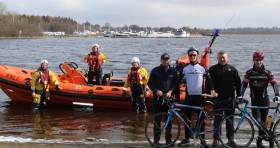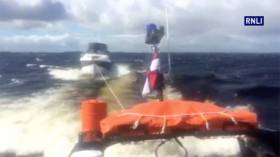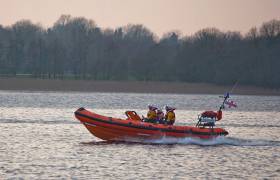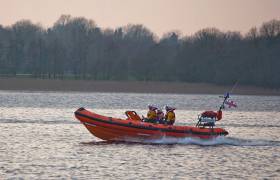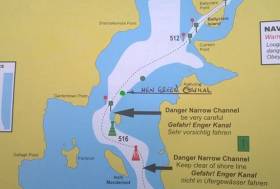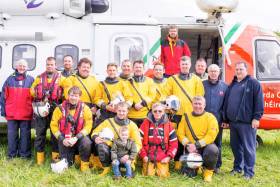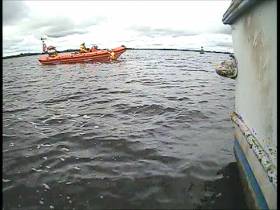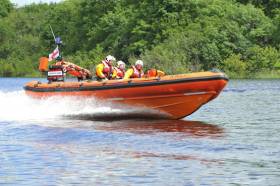Displaying items by tag: Lough Ree
Lough Ree Lifeboat Assists Fishermen After Boat Takes On Water
#RNLI - Two fishermen whose boat was taking on water were brought to safety by Lough Ree RNLI this week.
At 3.45pm on Wednesday (18 April), the volunteer lifeboat crew was tasked by Malin Head Coast Guard to go to the aid of two fishermen just south of Inchmore, near the eastern shore of Lough Ree.
While visibility was good, conditions on the lake were quite rough with a swell of 1-2 metres and strong winds measuring Force 6 coming from south-southwest.
The fishermen had got into difficulty when their 17ft aluminium boat began taking on water due to the size of the waves on the lake.
They made their way to the nearest island, Ilanfan, to bring the boat ashore before it could sink. From there they made contact with the coastguard to request assistance.
Lough Ree RNLI helm Tom Bradbury and crew Liam Sherringham and Shane McCormack arrived on scene at 4.10pm. Having ensured the two fishermen were uninjured and the casualty boat hadn’t been damaged by rocks on the island, they proceeded to bail the water out of it.
The lifeboat crew then towed the fishing boat alongside their vessel The Eric Rowse to bring it to deeper waters, where conditions were assessed to be severe enough to prompt a continued tow back to Coosan Point.
“Conditions on Lough Ree can vary greatly depending on the wind direction and speed,” Bradbury sail after the callout.
“We would advise all users of the lake to always ensure they carry a means of communication such as a mobile phone or VHF radio with them, like these two gentlemen did.”
Fifth ‘Lap Of Lough Ree’ Launched To Raise Funds For Local RNLI
#RNLI - Lough Ree RNLI has launched their fifth Lap of Lough Ree, which will take place this year on Sunday 22 April raising funds for the lifeboat service in Athlone.
The 85km cycle will go anti-clockwise around Lough Ree, starting and finishing at The Bounty at Buccaneers Rugby Club, with a pit-stop in Lanesborough at the north of Lough Ree.
Speaking at the launch yesterday (Monday 12 March), Lough Ree RNLI volunteer lifeboat press officer Sarah Bradbury said: “We are delighted with the support that the cycle has received each year and that it’s becoming a favourite in the cycling calendar.
“This is a relatively relaxed route for cyclists to ease themselves back into the saddle while taking in the stunning views of Lough Ree.
“Those who participate in the cycle do so knowing they are raising vital funds for Lough Ree RNLI and we would like to thank them in advance for that.”
Bradbury said funds raised will maintain and equip our inshore lifeboat and will allow the volunteer crew to continue to train and develop their lifesaving skills.
Registration for the event will start at 9am the day in The Bounty. The entry fee is €20. For more information visit the Lough Ree RNLI Facebook page or email [email protected].
Lough Ree Lifeboat Rescues Five On Cruiser Drifting Towards Rocks
#RNLI - Lough Ree RNLI were called to assist five people aboard a 20ft motor cruiser which had lost power and was drifting towards Nun’s Island yesterday afternoon (Saturday 9 September).
The crew of inshore lifeboat The Eric Rowse were alerted at 1.27pm and were in the water within 10 minutes, quickly making their way to the scene — by which time the vessel had been blown very near the north shore of Nun’s Island and was at imminent risk of serious damage.
Weather conditions at the time were reported as mainly dry, with a fresh Force 5 north-westerly wind and waves over a metre high.
The lifeboat crew went alongside the casualty vessel and found that the occupants were uninjured but distressed, while one person on board was suffering from motion sickness due to the heavy swell.
Lifeboat volunteer Emmet Devereaux remained with the casualty vessel to reassure those on board and to assist with steering, while the others set up a tow line and pulled the cruiser out of immediate danger.
The lifeboat then proceeded to tow the cruiser to safe harbour at Coosan Point. Lifeboat helm Stan Bradbury opted for a relatively fast tow, both to maintain directional control of the towed vessel and to shorten as much as possible the distress of its crew.
Lough Ree lifeboat operations manager Tony McCarth said later: “Lough Ree is 29 km long and 12km wide, so a sizeable swell can develop quickly, especially in a northerly or southerly breeze.
“We recommend that all lake users check the weather forecast, and the wind direction, when planning their journeys – fresh to strong wind conditions are forecast to continue for the next several days.”
#RNLI - Lough Ree RNLI was called to assist two sailors when their 17ft Fireball dinghy was holed and began to sink on Lough Ree on Saturday evening (15 July).
The crew of Lough Ree lifeboat The Eric Rowse were alerted by the Irish Coast Guard at 7pm when the sailors called for assistance over their portable VHF radio.
The Fireball was sinking after the rudder bracket broke away from the hull, causing the buoyancy tanks to fill with water.
Weather conditions at the time was wet and windy, with a Force 4-5 breeze, frequent showers and moderate visibility.
The lifeboat crew were on scene within minutes and recovered the two sailors, who had capsized the boat in order to slow the filling of the buoyancy tanks.
After establishing that both men were uninjured, the lifeboat crew and the sailors proceeded to turn the dinghy upright and lower the sails, and then towed it to the nearest island.
On reaching Beam Island, the five baled the water out of the dinghy and examined the damage to the hull, before towing the vessel to Lough Ree Yacht Club where it was recovered from the water.
Lough Ree RNLI helm Stan Bradbury said: “We were very happy to assist these experienced sailors when they ran into difficulty on the lake.
“Equipment failure can, and does, happen at unexpected times; these two had taken the necessary precautions before leaving shore, and followed the correct procedures to achieve a good outcome if anything went wrong.
“Calling for assistance early, before you become excessively cold or tired, is the best course of action if you find yourself in difficulty on the water.”
Saturday’s callout came days after an exceptionally busy week for the Midlands lifeboat crew, in which they assisted 30 people on seven vessels over a five-day period.
#RNLI - Lough Ree RNLI assisted 30 people aboard seven vessels during an exceptionally busy few days for the volunteers last week.
The crew of inshore lifeboat The Eric Rowse had an early start last on Sunday 2 July when they were dispatched to assist two people on board a motor cruiser aground west of Inch McDermott at 5.40am.
Over the course of the day, the lifeboat crew diverted from the Athlone RNLI River Festival several times to assist a further 16 people and three vessels experiencing various difficulties including running aground, engine failure and running out of fuel.
The lifeboat was called out again on Tuesday 4, Thursday 6 and Friday 7 July to assist a further 12 people aboard three motor cruisers in difficulty.
In all cases, the people on board were uninjured and were brought to safety by the lifeboat volunteers.
Speaking on Friday, Lough Ree RNLI Deputy Launching Authority Billy Henshaw said: “This is the busiest time of year on the lake, and it is great to see so many people enjoying all that Lough Ree has to offer.
“We would like to remind all users of the lake to ensure they stay SAFE: Spot the dangers, take Advice, inform a Friend of your plans and know what to do in an Emergency.
“It is also important to remain aware of where you are in relation to navigation markers.”
Lough Ree Lifeboat Assists Three After Late-Night Breakdown
#RNLI - Lough Ree RNLI assisted one man and two women after their boat broke down at the north end of Lough Ree last night (Monday 19 June).
The volunteer lifeboat crew was alerted by the Irish Coast Guard in Malin Head at 11.40pm to assist the speed boat located near Inch McDermott and Ferinch Islands.
Deputy launching authority Matt Harte with shore crew Eamon Flynn and Denis Buckley prepared inshore lifeboat The Eric Rowse for launch with helm Stan Bradbury and crew Kieran Scullion and Tony Diskin on board.
Weather conditions at the time were described as breezy with a Force 2-3 wind with heavy cloud cover, making it challenging for the lifeboat crew to locate the casualty vessel.
Upon arriving near Inch McDermott, the lifeboat crew lit two illumination flares to enable them to locate the speed boat. The three onboard were able to light a small fire to further enable the lifeboat crew to locate them on a rocky outcrop to the western side of Ferinch Island.
Having ensured everyone onboard was uninjured and inspected the boat for damage, a tow line was secured and man joined the crew on the inshore lifeboat to assist with navigation through a small channel to a nearby harbour on the shore.
Speaking following the callout, Stan Bradbury said: “We were delighted to be of assistance last night and would remind anyone planning a trip on the lake to always carry a means of calling or signalling for help. This becomes even more important at night or when visibility is reduced.”
Placement Of New Navigational Aid In Lough Ree
#InlandWaters - Waterways Ireland advises masters and users of the Shannon Navigation that a new green conical navigation aid has been placed north of Inch Macdermot Island in Lough Ree between the green perch and the green can buoy, as shown on the guide above.
#RNLI - Volunteers from Lough Ree RNLI had a successful training exercise with the Sligo-based Irish Coast Guard helicopter Rescue 118 yesterday (Sunday 11 June).
The lifeboat and helicopter crews came together for a joint training exercise at Lough Ree Yacht Club amid changeable weather conditions, with winds Force 4-6 and frequent rain showers blowing through.
On arrival, Rescue 118 landed at the yacht club grounds where the pilot and crew briefed the Lough Ree RNLI volunteers, after which they invited the RNLI crew, family members and yacht club members to have a tour of the helicopter.
The exercise got underway with the lifeboat crew members being winched between their inshore lifeboat The Eric Rowse and the helicopter. The strong winds enabled easier hovering for the helicopter, and provided the lifeboat crew with an invaluable experience.
Speaking following the exercise, Lough Ree RNLI volunteer deputy press officer Sarah Bradbury said: “Joint training exercises such as today’s allows our crews to develop their skills, work with and share learning experiences with our colleagues in the Irish Coast Guard and most importantly prepare for working effectively with each other when the time comes and we need to help someone in need.”
The exercise came days after a busy bank holiday weekend for the Lough Ree lifeboat, as previously reported on Afloat.ie.
#RNLI - A busy June bank holiday weekend for Lough Ree RNLI continued yesterday (Monday 5 June) with the rescue of six people across two grounded cruisers in a single callout.
The lifeboat crew were first alerted by the Irish Coast Guard after 10.20am to two people on board a 25ft motor cruiser that ran hard aground on rocks south of Bantry Bay near the eastern shore of the lake.
Lifeboat operations manager Tony McCarth, assisted by shore crew Denis Buckley and Eamon Flynn, had the inshore lifeboat The Eric Rowse launched and underway in less than 15 minutes, with crew members Kieron Sloyan, Emmet Devereaux and Kieran Scullion onboard.
Weather conditions at the time were calm and dry with spells of sunshine and a light Force 2 breeze.
The lifeboat crew were on scene near the casualty vessel at 11.01am. Due to the numerous rocks in the vicinity of the cruiser, crew member Emmet Devereaux left the lifeboat and waded to the cruiser to check that all onboard were uninjured and that the boat was not taking on water.
After walking the area around the boat, a deeper channel was located to safely tow the vessel to navigable water. The vessel was undamaged and the two men aboard were able to continue their journey north to Lanesborough under their own power.
As the lifeboat departed the scene, the crew noticed a 34ft motor cruiser aground a short distance away and approached the vessel to offer assistance to the two men and two women on board.
The cruiser in this case was not very hard aground and, after performing the usual checks, the vessel was towed to safe water and the four aboard continued their journey north to Lanesborough.
Speaking after the callout, Tony McCarth said: “We were happy to be able to assist both vessels today and to help these six people continue to enjoy their weekend on Lough Ree.
“Navigation markers on the lake are located so that each one can be seen from the one before. If you cannot see the next marker, slow down, check your location on your navigation chart and proceed with caution in its approximate direction until you see it.”
Yesterday’s callout was the third in as many days for the Lough Ree lifeboat, following an assist for a grounded cruiser on Sunday afternoon and a medevac for an island resident on Saturday.
Lough Ree Lifeboat Assists Two On Grounded Motor Cruiser
#RNLI - Lough Ree RNLI assisted two people aboard a grounded motor cruiser yesterday afternoon (Sunday 4 June) on the eastern shore of Lough Ree.
The alarm was raised at 12.19pm when two people on board the 34ft cruiser went aground in St Mark’s Bay.
Lough Ree lifeboat volunteers were quick to respond, with launching authority Billy Henshaw and shore crew launching The Eric Rowse in under 10 minutes with helm Kieran Sloyan and crew onboard.
Weather conditions at the time were breezy with a south-westerly Force 2-3 and occasional heavy downpours.
Upon arrival on scene, the lifeboat crew ensured that the two people on board were uninjured before assessing the boat which was hard aground on some rocks.
A tow line was established and the vessel was towed into deeper waters where the crew once again assessed the boat.
Although the hull appeared undamaged, there were some vibrations on driving which suggested possible damage to the propeller or rudder. A member of the lifeboat crew remained on board with the two people and the lifeboat escorted them to Quigley’s Marina.
The callout came less than 24 hours after the Lough Ree lifeboat assisted in the medevac of an island resident in need of emergency medical care, as previously reported on Afloat.ie.





























